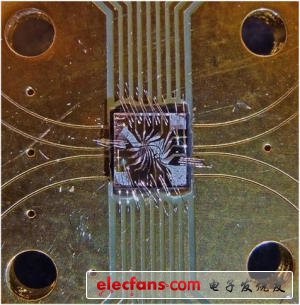Scientists made quantum computers in diamonds for the first time to prevent "decoherence" mechanisms, using microwave pulses to constantly switch the direction of electron spin.

Scientists make a quantum computer in a diamond, which is a pioneer. The chip size in the image is 3mm & TImes; 3mm, while the diamond in the center is 1mm & TImes; 1mm.
Diamonds are long-lasting, or, at least, the quantum calculations of diamonds are like this. A research team of scientists at the University of Southern California (USC) made a quantum computer inside a diamond, a pioneer that prevents "decoherence," a correlation that is a noise that prevents the computer from functioning properly. .
Demonstrations show that such viable solid-state quantum computers, unlike early gaseous and liquid systems, represent the future of quantum computing because they are easy to increase in size. Current quantum computers are usually very small, and although impressive, they still cannot match the speed of larger traditional computers.
The multinational research team includes Daniel Lidar, a professor at the University of Southern California, and Zhihui Wang, a postdoctoral fellow at the University of Southern California, and some researchers from the Delft University of Technology in the Netherlands. Iowa State University and the University of California, Santa Barbara. Their research was published in the April 5 issue of Nature, entitled "Decoherence-protected quantum gates for a hybrid solid-state spin register".
The research team's diamond quantum computer system has two qubits (called "qubits") that use subatomic particles.
The bits of the opposite traditional computer can be explicitly coded as 1 or 0, and the qubits can be coded as 1 and 0 at the same time. This property is called superposition, and quantum states can "tunnel" energy barriers, so one day the quantum computer will be optimized for calculations much faster than traditional computers.
Like all diamonds, the diamonds used by researchers also have impurities, something other than carbon. The more impurities in a diamond, the less attractive it is to make jewelry, because it makes the crystal look less shiny.
However, this research team is using these impurities themselves.
The impurity nitrogen nucleus will become the first bit. In the second defect, there is an electron that becomes the second qubit. More precisely, the "spin" of each subatomic particle is used as a qubit.
Electrons are smaller than nuclei and operate faster, but they are also more unstable and “decoherent†more quickly. Qubits use nucleus, which is larger and more stable, but slower.
"The nucleus has a long decoherence time of a few milliseconds. You can think this is very slow," said Leda, who works part-time at the USC Viterbi School of Engineering and the University of Southern California. School of Literature, Arts and Sciences (USC Dornsife College of Letters, Arts and Sciences).

Quantum gates operate in a decoherent environment
Although solid-state computing systems have existed before, this is the first time to add decoherence protection, using microwave pulses to continuously switch the direction of electron spin.
Leda said, "It's a bit like time travel," because switching the direction of rotation will reverse the contradictory motion over time, and the qubit will return to its original position.
The team can prove that their diamond packaging system does operate in a quantum way, but it depends on how closely it fits the "Grover's algorithm."
This algorithm is not new, it was invented by Lov Grover at Bell Labs in 1996, but it shows the future of quantum computing.
The test is to search for an unordered database, similar to asking for a name in the phone book, but asking you to know only the phone number.
Sometimes, on the first try, you will find it miraculously. Sometimes, you may have to rummaging through the entire book to find it. If you have done countless searches, on average, you have to find the name and need to search half of the phone book.
Mathematically, this can be expressed as, if you find the right choice, you need to make X / 2 attempts, and X is the total number of choices you need to search. So there are a total of four choices, and you find the right choice, and you need to try two on average.
Quantum computers use overlay properties to find the right choice, and more quickly. The math behind it is complex, but in practice, the quantum computer searches for four choices in the unordered list, and the first attempt will find the right choice, every time.
Although not perfect, this new computer can find the right choice for the first time in 95% of the time, which proves that it operates in a quantum manner.
Tiger Pcb Board,Tiger Circuit Board,Tiger Pcb Circuit Board,Tiger Pcb Motherboard
Guangzhou Ruihong Electronic Technology CO.,Ltd , https://www.callegame.com